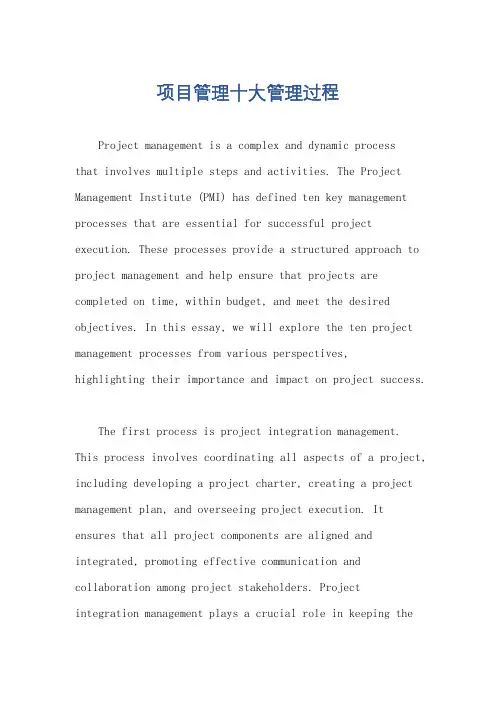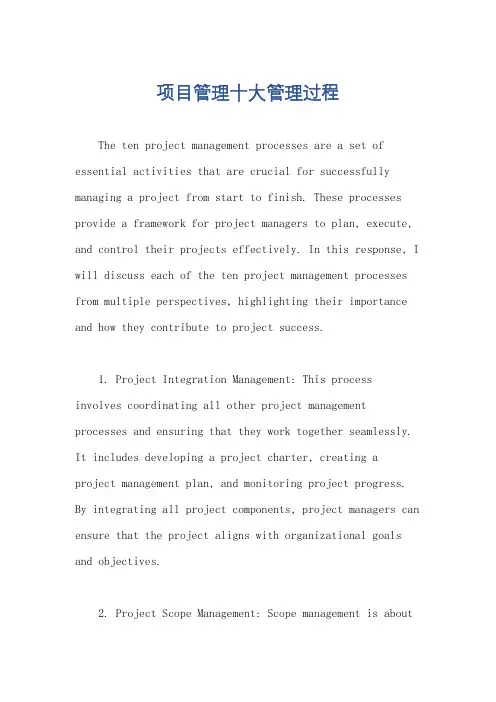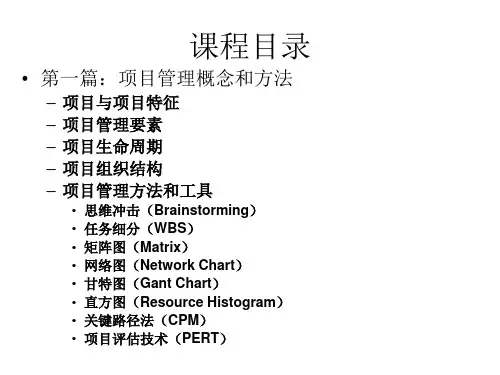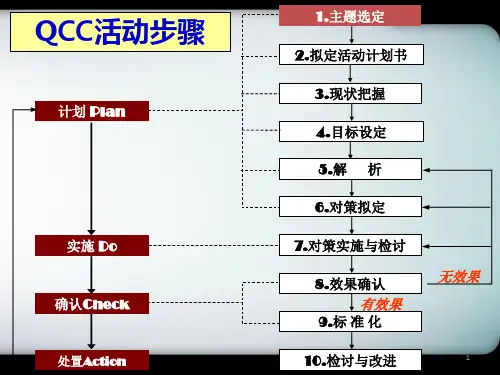项目管理十大步骤与成功的因素(ppt 182页)
- 格式:ppt
- 大小:1.39 MB
- 文档页数:180

项目管理十大管理过程Project management is a complex and dynamic processthat involves multiple steps and activities. The Project Management Institute (PMI) has defined ten key management processes that are essential for successful project execution. These processes provide a structured approach to project management and help ensure that projects are completed on time, within budget, and meet the desired objectives. In this essay, we will explore the ten project management processes from various perspectives,highlighting their importance and impact on project success.The first process is project integration management. This process involves coordinating all aspects of a project, including developing a project charter, creating a project management plan, and overseeing project execution. It ensures that all project components are aligned and integrated, promoting effective communication and collaboration among project stakeholders. Projectintegration management plays a crucial role in keeping theproject on track and ensuring that all deliverables are completed as planned.Next, we have project scope management. This process involves defining and controlling what is included and excluded in a project. It includes activities such as collecting requirements, creating a scope statement, and managing scope changes. Effective scope management is essential to prevent scope creep, where project boundaries expand beyond the original plan, leading to delays and cost overruns. By clearly defining project scope and managing changes, project managers can ensure that the project stays within its intended boundaries and objectives.Project time management is another critical process. It involves developing and controlling the project schedule, ensuring that activities are completed in a timely manner. This process includes activities such as defining project activities, sequencing them, estimating their durations, and creating a project schedule. Effective time management allows project managers to allocate resources efficiently, identify potential delays, and take corrective actions tokeep the project on schedule. Timely completion of project activities is crucial for meeting project deadlines and delivering results on time.Cost management is also a vital project management process. It involves estimating, budgeting, and controlling project costs. This process includes activities such ascost estimation, cost budgeting, and cost control.Effective cost management helps project managers allocate resources effectively, monitor project expenditures, and identify cost-saving opportunities. By closely managing project costs, project managers can ensure that the project remains within budget and avoid financial risks or overruns.Quality management is another essential process in project management. It involves establishing quality objectives, determining quality standards, and ensuringthat project deliverables meet these standards. Quality management activities include quality planning, quality assurance, and quality control. By implementing effective quality management processes, project managers can ensure that the project meets the desired level of quality andcustomer satisfaction. This, in turn, enhances theproject's reputation and increases the likelihood of future success.Another critical process is human resource management.It involves planning, acquiring, developing, and managing the project team. Human resource management activities include team building, training, and performance evaluation. Effective human resource management ensures that theproject team has the necessary skills and capabilities to successfully execute the project. It also promotes apositive work environment, fosters teamwork, and enhances overall project performance.Communication management is a process that focuses on planning, executing, and controlling project communications. It involves identifying project stakeholders, determining their communication needs, and establishing effective communication channels. Communication management activities include creating a communication plan, conducting meetings, and distributing project information. Effective communication management promotes transparency, facilitatesinformation flow, and ensures that project stakeholders are well-informed. It also helps manage conflicts, resolve issues, and maintain positive relationships among project team members and stakeholders.Risk management is another crucial process in project management. It involves identifying, analyzing, and responding to project risks. Risk management activities include risk identification, risk assessment, risk mitigation, and risk monitoring. Effective risk management allows project managers to anticipate potential threats and develop strategies to minimize their impact. It also helps project teams adapt to unforeseen circumstances and ensures that projects are delivered with minimal disruptions.Procurement management is a process that focuses on acquiring goods and services from external sources. It involves activities such as procurement planning, solicitation, vendor selection, and contract management. Effective procurement management ensures that project teams have the necessary resources and materials to execute the project successfully. It also helps manage vendorrelationships, negotiate contracts, and ensure that procurement activities are conducted in a fair and transparent manner.Finally, stakeholder management is a process that involves identifying, analyzing, and engaging project stakeholders. It includes activities such as stakeholder identification, stakeholder analysis, and stakeholder engagement. Effective stakeholder management helps project managers understand the needs and expectations of different stakeholders and ensures their active involvement throughout the project lifecycle. By engaging stakeholders, project managers can gain their support and commitment, which is crucial for project success.In conclusion, project management is a complex process that requires careful planning, coordination, and control. The ten management processes discussed above provide a comprehensive framework for managing projects effectively. Each process plays a unique role in ensuring project success, from integrating project components to managing stakeholders and risks. By understanding and implementingthese processes, project managers can improve project outcomes, enhance team performance, and deliver successful projects.。


项目管理十大管理过程The ten project management processes are a set of essential activities that are crucial for successfully managing a project from start to finish. These processes provide a framework for project managers to plan, execute, and control their projects effectively. In this response, I will discuss each of the ten project management processes from multiple perspectives, highlighting their importance and how they contribute to project success.1. Project Integration Management: This process involves coordinating all other project management processes and ensuring that they work together seamlessly. It includes developing a project charter, creating aproject management plan, and monitoring project progress. By integrating all project components, project managers can ensure that the project aligns with organizational goals and objectives.2. Project Scope Management: Scope management is aboutdefining and controlling what is included and excluded from the project. It involves collecting requirements, defining the project scope, and managing changes to the scope. Effective scope management helps project managers avoid scope creep and ensures that the project delivers the intended outcomes within the defined boundaries.3. Project Schedule Management: This process involves developing and controlling the project schedule. Itincludes activities such as defining activities, sequencing them, estimating durations, and creating a project schedule. By effectively managing the project schedule, project managers can ensure that tasks are completed on time, resources are allocated efficiently, and project deadlines are met.4. Project Cost Management: Cost management is about estimating, budgeting, and controlling project costs. It includes activities like cost estimation, cost budgeting, and cost control. By closely monitoring project costs, project managers can identify cost overruns, make necessary adjustments, and ensure that the project is completedwithin the allocated budget.5. Project Quality Management: Quality management aimsto ensure that the project meets the specified quality standards. It involves activities such as quality planning, quality assurance, and quality control. By implementing effective quality management processes, project managerscan minimize defects, improve customer satisfaction, and enhance the overall project outcome.6. Project Resource Management: Resource management involves identifying, acquiring, and managing project resources effectively. It includes activities like resource planning, resource acquisition, and resource development.By ensuring that the right resources are available at the right time, project managers can optimize resource utilization, minimize delays, and enhance project efficiency.7. Project Communication Management: Communication is crucial for project success. This process involves planning, executing, and controlling project communications. Itincludes activities such as identifying stakeholders, defining communication channels, and managing project information. By maintaining open and effective communication, project managers can keep stakeholders informed, resolve conflicts, and foster collaboration among team members.8. Project Risk Management: Risk management aims to identify, assess, and mitigate project risks. It involves activities like risk identification, risk analysis, andrisk response planning. By proactively managing risks, project managers can minimize the likelihood and impact of negative events, making the project more resilient and increasing the chances of success.9. Project Procurement Management: Procurement management involves acquiring goods and services from external sources to support the project. It includes activities such as procurement planning, solicitation, and contract administration. By effectively managing procurement processes, project managers can ensure that the right vendors are selected, contracts are executed smoothly,and project deliverables are of high quality.10. Project Stakeholder Management: Stakeholder management is about identifying and engaging stakeholders throughout the project lifecycle. It includes activities like stakeholder identification, stakeholder analysis, and stakeholder engagement. By actively involving stakeholders, project managers can gain their support, manage their expectations, and increase the likelihood of project success.In conclusion, the ten project management processes provide a comprehensive framework for managing projects effectively. Each process plays a crucial role in different aspects of project management, from planning and execution to control and communication. By understanding and implementing these processes, project managers can enhance project outcomes, minimize risks, and ensure successful project delivery.。


项目管理的十个步骤解析管理风险和问题是成功的项目管理的基础。
本章能够帮助您了解如何让您的项目团队识别风险和问题,分析它们,开发应对表以及实施这些应对表。
杰出的项目团队与一般的团队之间的区别在于:一般的团队只为成功做计划,而杰出的团队却认识到了影响绩效的许多威胁。
近年来,项目管理领域越来越关注失败项目的影响,并将它引入项目风险管理的必备程序和工具。
如果您在项目的计划和实施过程中引入了风险和问题管理,那么项目成功的概率也大大增加了。
介绍这个重要的命题前,我们首先介绍风险和问题的定义。
一个风险事件指二个不连续发生的事件,被认为是导致某事物发生的原因以及相应的结果。
风险事件的发生是有概率的。
一个通常用于识别风险的标准是“可能发生,可能不发生。
”如果该风险事件发生了,就会导致风险结果。
所有这三个因素(风险、事件、结果)是界定一个风险不可或缺的。
相对于风险的离散、不确定性,问题却是确定的。
因此,与风险的估计和管理也有所不同。
如果某个事件百分之百发生,就肯定不是风险,而是必然的事情。
因此,如果您能确定它会发生,或它已经发生,这就是问题。
您还应该解决该问题对后续活动可能造成的影响。
举个关于风险的案例:某一天的清晨,天气多云。
您查看了天气预报,说今天雷阵雨的概率是50%。
您将“雷阵雨”定义为事件,并估计了发生的概率以及相应的可能结果。
谨慎起见,您决定在您的日程计划中加人应急储备。
您带上了雨伞,以防风险事件的发生。
再看一个问题的案例。
假设您现在看到窗外的雨下得很大。
降雨不再是一个风险,而是一个您必须管理的确定事件。
因为是一个确定的时间,要求您接受现实并以积极地态度解决问题。
作为一个理智、谨慎的人,您不应该傻傻的认为没有下雨的可能性,或认为您能变成超人阻止下雨。
所以,带好您的雨衣,即时打开您的雨伞!以团队为基础的项目管理的十个步骤所有好的项目团队是用合作的方式进行风险识别、分析以及应对的。
打个比方说,这些项目都有‘‘雷达’’对即将出现的威胁进行监控。




